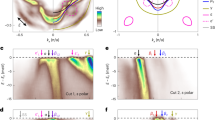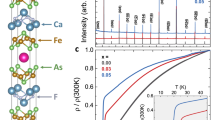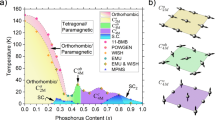Abstract
The superconducting-gap distribution is a pivotal characteristic for a superconductor. Whereas the cuprates and conventional phonon-mediated superconductors are characterized by distinct d-wave and s-wave pairing symmetries with nodal and nodeless gap distributions respectively, the superconducting-gap distributions in iron-based superconductors are rather diversified. Whereas nodeless gap distributions have been directly observed in Ba1−xKxFe2As2, BaFe2−xCoxAs2, KxFe2−ySe2 and FeTe1−xSex (refs 1, 2, 3, 4), the signatures of nodal superconducting gaps have been reported in LaOFeP, LiFeP, KFe2As2, BaFe2(As1−xPx)2, BaFe2−xRuxAs2 and FeSe (refs 5, 6, 7, 8, 9, 10, 11, 12). We here report the angle-resolved photoemission spectroscopy measurements on the superconducting-gap structure of BaFe2(As0.7P0.3)2, and in particular the direct observation of a circular line node on the largest hole Fermi surface around the Z point at the Brillouin zone boundary. Our findings rule out a d-wave-pairing origin for the nodal gap, and establish the existence of nodes in iron pnictides under the s-wave pairing symmetry.
This is a preview of subscription content, access via your institution
Access options
Subscribe to this journal
Receive 12 print issues and online access
$259.00 per year
only $21.58 per issue
Buy this article
- Purchase on SpringerLink
- Instant access to full article PDF
Prices may be subject to local taxes which are calculated during checkout




Similar content being viewed by others
References
Ding, H. et al. Observation of Fermi-surface-dependent nodeless superconducting gaps in Ba0.6K0.4Fe2As2 . Europhys. Lett. 83, 47001 (2008).
Terashima, K. et al. Fermi surface nesting induced strong pairing in iron-based superconductors. Proc. Natl Acad. Sci. USA 106, 7330–7333 (2009).
Zhang, Y. et al. Nodeless superconducting gap in AxFe2Se2 (A=K,Cs) revealed by angle-resolved photoemission spectroscopy. Nature Mater. 10, 273–277 (2011).
Miao, H. et al. Isotropic superconducting gaps with enhanced pairing on electron Fermi surfaces in FeTe0.55Se0.45. Preprint at http://arxiv.org/abs/1107.0985 (2011).
Fletcher, J. D. et al. Evidence for a nodal-line superconducting state in LaFePO. Phys. Rev. Lett. 102, 147001 (2009).
Hashimoto, K. et al. Line nodes in the energy gap of superconducting BaFe2(As1−xPx)2 single crystals as seen via penetration depth and thermal conductivity. Phys. Rev. B 81, 220501 (2010).
Yamashita, M. et al. Nodal gap structure of superconducting BaFe2(As1−xPx)2 from angle-resolved thermal conductivity in a magnetic field. Phys. Rev. B 84, 060507 (2011).
Nakai, Y. et al. 31P and 75As NMR evidence for a residual density of states at zero energy in superconducting BaFe2(As0.67P0.33)2 . Phys. Rev. B 81, 020503 (2010).
Hashimoto, K. et al. Nodeless vs nodal order parameters in LiFeAs and LiFeP superconductors. Preprint at http://arxiv.org/abs/1107.4505 (2011).
Dong, J. K. et al. Quantum criticality and nodal superconductivity in the FeAs-based superconductor KFe2As2 . Phys. Rev. Lett. 104, 087005 (2010).
Qiu, X. et al. Nodal superconductivity in Ba(Fe1−xRux)2As2 induced by isovalent Ru substitution. Preprint at http://arxiv.org/abs/1106.5417 (2011).
Song, C. L. et al. Direct observation of nodes and twofold symmetry in FeSe superconductor. Science 332, 1410–1413 (2010).
Mazin, I. I., Singh, D. J., Johannes, M. D. & Du, M. H. Unconventional superconductivity with a sign reversal in the order parameter of LaFeAsO1−xFx . Phys. Rev. Lett. 101, 057003 (2008).
Kuroki, K. et al. Unconventional pairing originating from the disconnected Fermi surfaces of superconducting LaFeAsO1−xFx . Phys. Rev. Lett. 101, 087004 (2008).
Seo, K., Bernevig, A. B. & Hu, J. Pairing symmetry in a two-orbital exchange coupling model of oxypnictides. Phys. Rev. Lett. 101, 206404 (2008).
Hu, J. P. & Ding, H. Local antiferromagnetic exchange and collaborative Fermi surface as key ingredients of high temperature superconductors. Preprint at http://arxiv.org/abs/1107.1334 (2011).
Chen, C. T., Tsuei, C. C., Ketchen, M. B., Ren, Z. A. & Zhao, Z. X. Integer and half-integer flux-quantum transitions in a niobium-iron pnictide loop. Nature Phys. 6, 260–264 (2010).
Hanaguri, T., Niitaka, S., Kuroki, K. & Takagi, H. Unconventional s-wave superconductivity in Fe(Se,Te). Science 328, 474–476 (2010).
Kuroki, K., Usui, H., Onari, S., Arita, R. & Aoki, H. Pnictogen height as a possible switch between high- T c nodeless and low- T c nodal pairings in the iron-based superconductors. Phys. Rev. B 79, 224511 (2009).
Wang, F., Zhai, H. & Lee, D-H. Nodes in the gap function of LaFePO, the gap function of the Fe(Se,Te) systems, and the STM signature of the s± pairing. Phys. Rev. B 81, 184512 (2010).
Thomale, R., Platt, C., Hanke, W. & Bernevig, B. A. Why some iron-based superconductors are nodal while others are nodeless. Phys. Rev. Lett. 106, 187003 (2011).
Laad, M. S. & Craco, L. Theory of multiband superconductivity in iron pnictides. Phys. Rev. Lett. 103, 017002 (2009).
Wang, F., Zhai, H. & Lee, D-H. Nodes in the gap function of LaFePO, the gap function of the Fe(Se,Te) systems, and the STM signature of the s± pairing. Phys. Rev. B 81, 184512 (2010).
Suzuki, K., Usui, H. & Kuroki, K. Possible three dimensional nodes in the s± superconducting gap of BaFe2(As1−xPx)2 . J. Phys. Soc. Jpn 80, 013710 (2011).
Su, Y., Setty, C., Wang, Z. & Hu, J. Inter-layer superconducting pairing induced c-axis nodal lines in iron-based superconductors. Preprint at http://arxiv.org/abs/1110.0695 (2011).
Ye, Z. R. et al. Phosphor induced significant hole-doping in ferropnictide superconductor BaFe2(As1−xPx)2. Preprint athttp://arxiv.org/abs/1105.5242 (2011).
Yoshida, T. et al. Two-dimensional and three-dimensional Fermi surfaces of superconducting BaFe2(As1−xPx)2 and their nesting properties revealed by angle-resolved photoemission spectroscopy. Phys. Rev. Lett. 106, 117001 (2011).
Shimojima, T. et al. Orbital-independent superconducting gaps in iron-pnictides. Science 332, 564–567 (2011).
Zhang, Y. et al. Out-of-plane momentum and symmetry-dependent energy gap of the pnictide Ba0.6K0.4Fe2As2 superconductor revealed by angle-resolved photoemission spectroscopy. Phys. Rev. Lett. 105, 117003 (2010).
Acknowledgements
The authors thank J. P. Hu and X. H. Chen for discussions, and thank D. H. Lu for the experimental assistance at SSRL. This work is supported in part by the National Science Foundation of China, Ministry of Education of China, Shanghai Municipal Science and Technology Committee and the National Basic Research Program of China (973 Program) under grant Nos 2012CB921400, 2011CB921802 and 2011CBA00112. SSRL is operated by the US Department of Energy, Office of Basic Energy Science, Divisions of Chemical Sciences and Material Sciences.
Author information
Authors and Affiliations
Contributions
Y.Z., Q.Q.G., Z.R.Y., F.C., M.X. and B.P.X. made ARPES measurements. Z.R.Y. and J.J. conducted sample characterization measurements. Z.R.Y. and Y.Z. grew the samples and analysed the ARPES data. D.L.F. and Y.Z. wrote the paper. D.L.F. is responsible for the infrastructure, project direction and planning.
Corresponding author
Ethics declarations
Competing interests
The authors declare no competing financial interests.
Supplementary information
Supplementary Information
Supplementary Information (PDF 1500 kb)
Rights and permissions
About this article
Cite this article
Zhang, Y., Ye, Z., Ge, Q. et al. Nodal superconducting-gap structure in ferropnictide superconductor BaFe2(As0.7P0.3)2. Nature Phys 8, 371–375 (2012). https://doi.org/10.1038/nphys2248
Received:
Accepted:
Published:
Issue date:
DOI: https://doi.org/10.1038/nphys2248
This article is cited by
-
Temperature Dependence of the Superconducting Order Parameter in Stoichiometric Alkali Metal-Based Pnictide EuCsFe\(_4\)As\(_4\)
Journal of Superconductivity and Novel Magnetism (2024)
-
Research Progress of FeSe-based Superconductors Containing Ammonia/Organic Molecules Intercalation
Topics in Current Chemistry (2022)
-
Revealing the intrinsic superconducting gap anisotropy in surface-neutralized BaFe2(As0.7P0.3)2
Communications Physics (2021)
-
High temperature superconductivity at FeSe/LaFeO3 interface
Nature Communications (2021)
-
Superconducting-Gap Anisotropy of Iron Pnictides Investigated via Combinatorial Microwave Measurements
Scientific Reports (2020)



